The Meiningen Pastel - Bach Through The Eyes Of His Relatives Pages at The Face Of Bach
Page 2 - Is It An Accurate Depiction of the Facial Features of Johann Sebastian Bach?
The Face Of Bach
This remarkable photograph is not a computer generated composite; the original of the Weydenhammer Portrait Fragment, all that
remains of the portrait of Johann Sebastian Bach that belonged to his pupil Johann Christian Kittel, is resting gently on the surface
of the original of the 1748 Elias Gottlob Haussmann Portrait of Johann Sebastian Bach.
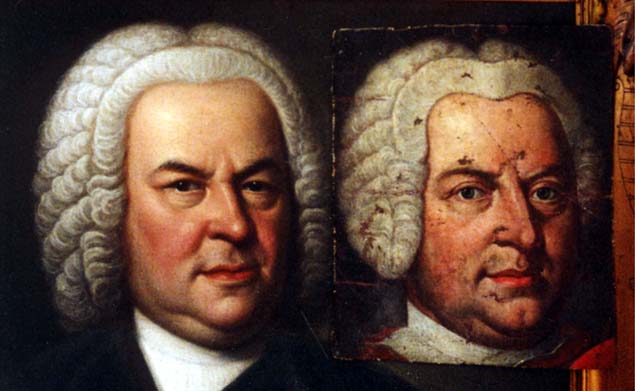
1748 Elias Gottlob Haussmann Portrait, Courtesy of William H. Scheide, Princeton, New Jersey
Weydenhammer Portrait Fragment, ca. 1733, Artist Unknown, Courtesy of the Weydenhammer Descendants
Photograph by Teri Noel Towe
©Teri Noel Towe, 2001, All Rights Reserved
The Meiningen Pastel
Bach Through The Eyes of His Relatives
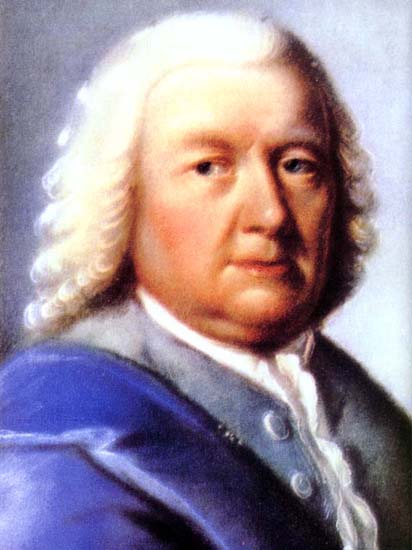
Part Two
Is It An Accurate Depiction of the Facial Features of Johann Sebastian Bach?
The physiognomical characteristics that traditionally have been considered essential to an accurate depiction of Bach's face are:
- A massive skull,
- A receding forehead,
- drooping eyelids, particularly over the right eye,
- shallow eye-sockets,
- unusual asymmetry of the eyes,
- predominantly blue color of the eyes, and
- protruding jaw and double chin
To this list, I would add another four, some of which, arguably, are refinements of traditional ones:
- a distinctive and asymmetrical furrowed brow that gives Bach an aura that is at once severe and mischievous,
- the long nose with what appears to be a slight arch about a third of the way down the bridge. (This part of the
nose is one of the anatomical details for which the 1746 Haussmann painting is particularly unreliable.)
- the distinctive shape of the mouth, the lower lip, and the crease at the right side of the mouth. This aspect of
Bach's face is particularly distinct in the 1748 Haussmann.
- the distinctive outline of the cheekbone and the jaw on the left side of the face, an outline that can be perceived
clearly in the boundaries between light and shadow on the face.
The image that is the standard for comparison is the 1748 Haussmann Portrait:
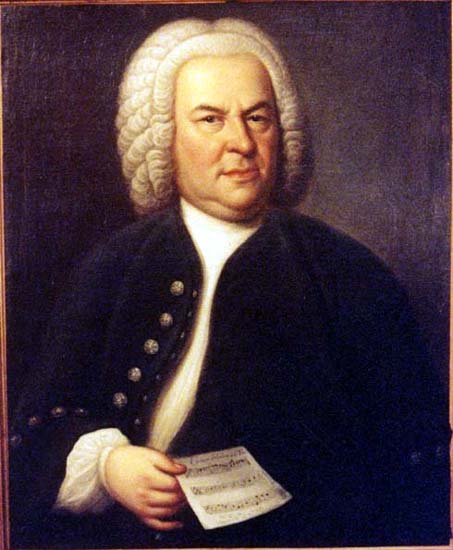

Now, just the heads:
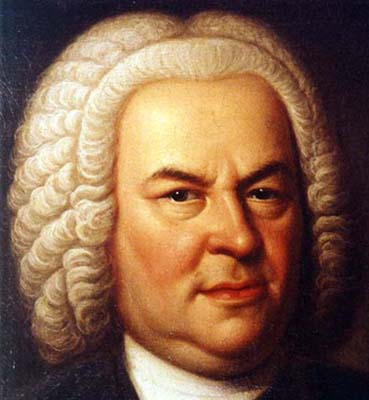

The image on the left is a detail from a photograph of the 1748 Haussmann portrait that I took in Princeton in early November,
2000; this detail is what I call a Weydenhammer Equivalent; the image on the right is the Weydenhammer Equivalent of the
Meiningen Pastel.. For the sake of completeness, even though the painting has been damaged so heavily and overpainted so many
times, the 1746 Haussmann Portrait must be included. As a physiognomical standard, the painting can be used only in its unrestored
state, and there, essentially, as a confirmation or as a reminder of those areas in which the painting is completely unreliable. The
Weydenhammer Equivalent of the 1746 Haussmann Portrait, from a photograph of the painting with all of the overpaint removed
that was taken in 1914, is now added to the equation for those restricted purposes.
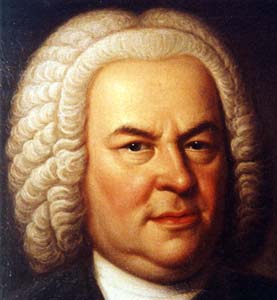

 .
.
The possibility that the faces of the Haussmann portraits and the face of the Meiningen Pastel are one and the same becomes even
more apparent when one studies just the faces, without the distractions of the perruques and the clothing.
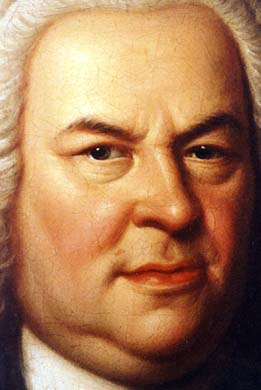
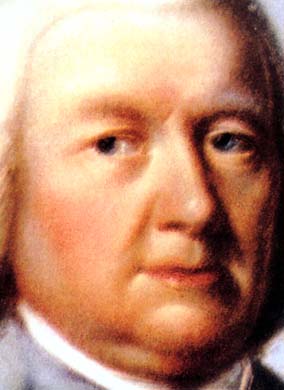

The distinctive outline of the cheekbone and the jaw on the left side of the face, an outline that can be perceived clearly in the
boundaries between light and shadow on the face in the 1748 Haussman Portrait (This portion of the face of the 1746 Haussmann
Portrait is not in good condition and therefore has little probative value.), is for all practical purposes identical in the Meiningen
Pastel.
Both faces are the faces of heavy men, and the distinctive shadow that the "upper" chin casts on the "lower" is also nearly identical,
but the Bach of the Meiningen Pastel is by no means as heavy as the Bach of the Haussmann Portraits, who is, to put it bluntly,
obese. The jowls, for instance, are nowhere near as heavy, and, when the jowls meet the collar, there is still a hint of a neck. The
reductionin subcutaneous fat that accompanies the reductions in weight also explains the hint of a chin dimple, similar to that in the
Weydenhammer Portrait Fragment and the Volbach Portrait, both of which potray a Bach who was much thinner.
Having enumerated and described the physiognomical characteristics of Bach's face that must be taken into consideration in
evaluating any image that is claimed to depict accurately the face of Johann Sebastian Bach, let me now compare these three faces,
anatomical detail by anatomical detail, starting at the top and working down. Descriptions that refer to "left" or "right", are from
Bach's perspective, not the viewer's, unless otherwise indicated. The 1748 Haussmann Portrait is the top, or lefthand, image, the
1746 Haussmann Portrait is the bottom, or righthand, image, and the Berlin Portrait is the middle image. Please remember
throughout this process that the original of the Meiningen Pastel is about 1/4 of the size of the original of the 1748 Haussmann
Portrait. The Meiningen Pastel is a "snapshot" sized image, and a pastel besides, which means that the detail will not be anywhere
near as fine. Finally, please remember that Bach's head is at slightly different angle, which means that the facial details are not quite
parallel in the comparison images.
First, the distinctive furrowed brow:



The same distinctive asymmetry is in evidence. In all three images, the right brow meets the bridge of the nose almost exactly the
same distance above the point at which the left brow meets the nose. Furthermore, the distinctive upward creases in the skin where
the brows meet the bridge of the nose are evident in all three portraits. Although the brows seem hairless, which makes it difficult to
trace them with precision, the arch of the right brow nonetheless can be be made out.
Next, the eyelids and eyes:



Once again, the simlarities are immediately apparent, the relative lack of detail in the diminutive pastel notwithstanding..
First, the fully developed ptosis (or blepharochalasis) that is so much a hallmark of the Haussmann depiction of Bach can be
clearly seen. Also,in all three images, the development of the ptosis in the left eye lags behind the development of the ptosis in the
right eye.
Second, please note, especially when one takes into consideration the size of the portrait and the medium, the remarkable similarity
between the shapes of the lower right lids in all three paintings. There is a distinctive "curve" just to the viewer's left of the point at
which the lid meets the nose that can be seen clearly in both the 1748 Haussmann and the Meiningen Pastel. Although it is a bit
blurry in the blown-up detail of the photo of the unrestored 1746 Haussmann, this quirk is still clearly discernible. The distinctive,
and very much different configuration of the left eye where it meets the nose is remarkably similar in all three. Finally, the irises of
the Meiningen Pastel's eyes appear to be abnormally large, like the irises of the eyes of the 1748 Haussmann Portrait.
Observations about the similarity of the eye color are perilous, if one goes beyond observing that the Bach of the Meiningen Pastel
has blue-grey eyes.
Next, let us have a look at the bags under Bach's eyes.



The 1746 Haussmann is of little value because of its poor condition in this area, but, even so, one can make out the distinctive
semicircular curve that begins at the nose end of the right eye. There is enough detail in the Meiningen Pastel to make it possible to
trace not only that curve but also the distinctive and anomalous shape of the bags under under the left eye that is clearly visible in
the 1748 Haussmann.
Next, the nose:
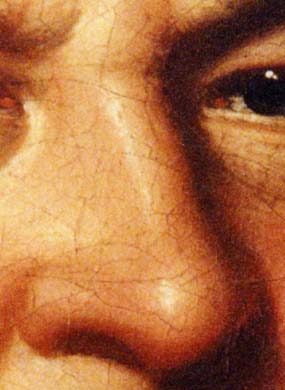
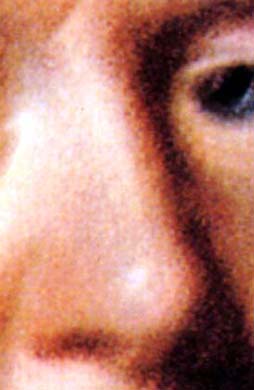
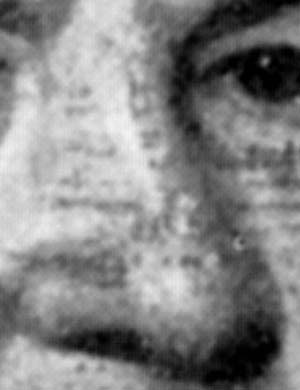
Despite the slightly different agnle of the pose, the similarities once again are immediately apparent. The distinctive arch on the left
side of the nose is seen in clearly in the details from the 1748 Haussmann and the Meiningen Pastel, and the essential shape and flair
of the right nostril seem very much the same. The 1746 Haussmann, alas, has negligible probative value because of the severe paint
loss to the nose, especially the bridge.
Now, the mouth:

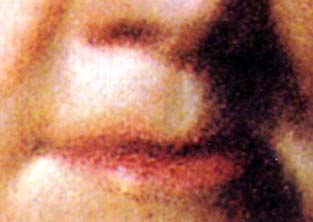
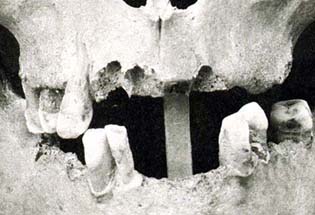

I have added a detail of the frontal photograph of the skull to aid in this comparison. I have also included the 1746 Haussmann,
although its probative value is minimal because of all the surface damage and abrasion in this area. Once again, the similarities are
striking. The tight, deep creases where the lips meet the cheeks are identical, and the lower jaw clearly extends beyond the upper in
the Meiningen Pastelt, as it does in both of the Haussmann portraits and the skull. It should also be noted that the contour of the
upper lip would follow that of the 1748 Haussmann almost exactly were it not "firmer". Because this contour accurately reflects the
evidence provided by the skull regarding Bach's dentition, the mouth of the 1748 Haussmann Portrait is a mouth that is missing
quite a few teeth. The mouth of the Bach of the Meiningen Pastel is a mouth with more teeth in it, and that allowance has to be made
in assessing the authenticity of the portrait, because the portrait might well depict a man several years younger than the Bach of the
Haussmann Portraits, and a few years older than the Bach of the Weydenhammer Portrait Fragment, a Bach who appears to have
had a few more teeth than the Bach of the Meiningen Pastel:
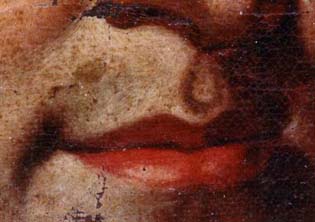


The question of the number of teeth that were actually still in Bach's jaws at the time that a given portrait was painted undeniably an
important secondary issue that affects the comparison of the appearance of Bach's mouth. Bach's skull is missing quite a few teeth,
and, although one must allow for the probability, if not the certainty, that teeth may have been lost (The skeleton is incomplete, to
begin with, and the condition of the upper jaw suggests that the upper lateral and central right teeth, and perhaps the upper left
lateral were dislodged and lost either during the 144 years of interment or during the exhumation process.), the configuration of the
mouth in both the Meiningen Pastel and the 1748 Haussmann Portrait confirms that there were teeth missing, but the condition of
the upper and lower jaws also confirms that there was intermaxillary support that prevented total collapse and a "toothless" look.
The need to allow for and compensate for the uncertainties of the state of Bach's dentition at various times of his life complicates
any authentication process, since, at least until the appearance of the Weydenhammer Portrait Fragment, which I have demonstrated
conclusively is what remains of the long lost portrait of Bach that belonged to Kittel, all of our authentic standards for comparison
date from the end of his life.
Finally, I must add that these especially large sized details show that the shape of the upper lip is identical to that in both the 1748
Haussmann Portrait and the Weydenhammer Portrait Fragment, a subtlety that is not immediately apparent when one considers the
face of the Meiningen Pastel in toto.



As I near the end of this segment, I find myself unable to resist sharing with you my personal reaction to the Meiningen Pastel, a
reaction that I feel even more strongly now that I have read Christoph Wolff's perceptive analysis and touching description of what
little we know about how much Sebastian Bach treasured and loved his family. In the summer of 1741, Anna Magdalena, then 40
and pregnant with what turned out to be her last child, fell seriously ill. Bach was away at the time, and we know from drafts of
correspondence sent to him that fortuitously have survived, that she was ill for several weeks after Bach's return home. (See Wolff,
JSBTLM, 2000, p. 393, ff.)
Meaning, like beauty, is in the eye and soul of the beholder, and emotional reactions of this kind have negligible probative value
when applying the rigorous discipline of scholarship, but there is no harm in expressing them. Ever since I first came in contact with
the Meiningen Pastel, I have been taken by the distracted, anxious expression on Bach's face. Besides, elegantly dressed though he
is, he looks tired and harried.
For that reason, I personally believe the Meiningen Pastel to be either the original or a replica made by the artist of a portrait from
life that Gottlieb Friedrich made on a visit to Leipzig late in 1741 or early in 1742.

August, 2000
Revised and augmented, August 16, 2001
Please click on  to go back to Page 1.
to go back to Page 1.
Please click on  to return to the Index Page at The Face Of Bach.
to return to the Index Page at The Face Of Bach.
Please click on  to visit the Johann Sebastian Bach Index Page at Teri Noel Towe's Homepages.
to visit the Johann Sebastian Bach Index Page at Teri Noel Towe's Homepages.
Please click on the  to visit the Teri Noel Towe Welcome Page.
to visit the Teri Noel Towe Welcome Page.
TheFaceOfBach@aol.com
Copyright, Teri Noel Towe, 2000 , 2002
Unless otherwise credited, all images of the Weydenhammer Portrait: Copyright, The Weydenhammer Descendants, 2000
All Rights Reserved
The Face Of Bach is a PPP Free Early Music website.

The Face Of Bach has received the HIP Woolly Mammoth Stamp of Approval from The HIP-ocrisy Home Page.